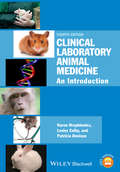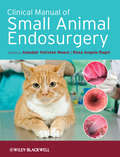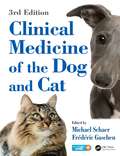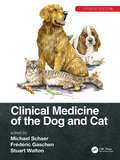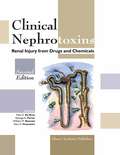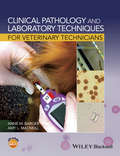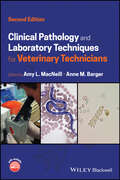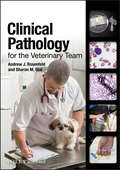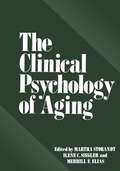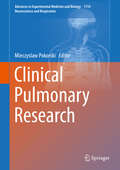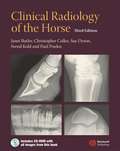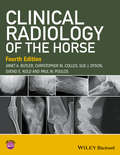- Table View
- List View
Clinical Laboratory Animal Medicine: An Introduction
by Karen Hrapkiewicz Lesley A. Colby Patricia DenisonClinical Laboratory Animal Medicine: An Introduction, Fourth Edition offers a user-friendly guide to the unique anatomy and physiology, care, common diseases, and treatment of small mammals and nonhuman primates. Carefully designed for ease of use, the book includes tip boxes, images, and review questions to aid in comprehension and learning. The Fourth Edition adds new information on transgenic mice, drug dosages, techniques, and environmental enrichment, making the book a comprehensive working manual for the care and maintenance of common laboratory animals. The book includes information on topics ranging from genetics and behavior to husbandry and techniques in mice, rats, gerbils, hamsters, guinea pigs, chinchillas, rabbits, ferrets, and nonhuman primates. A companion website provides editable review questions and answers, instructional PowerPoints, and additional images not found in the book. Clinical Laboratory Animal Medicine is an invaluable resource for practicing veterinarians, veterinary students, veterinary technicians, and research scientists.
Clinical Manual of Small Animal Endosurgery
by Alasdair Hotston Moore Rosa Angela RagniA practical and comprehensive guide to rigid endoscopy and endosurgery in small animal practice. Fully illustrated throughout, it covers the clinical treatment of small animals from pre-operative through to post-operative care. With reference to specific procedures, this manual includes guidance on the selection of equipment, surgical techniques, anaesthesia and possible complications. A specialist chapter advising on the treatment of birds, reptiles and small mammals is also included. Clinical Manual of Small Animal Endosurgery will enable veterinarians to develop and improve their endoscopic techniques in clinical practice, as well as providing guidance on referral options for more complex cases. KEY FEATURES • Provides comprehensive information on how to perform rigid endoscopic investigations and procedures. • The focus is on dogs and cats with a specialist chapter covering the treatment of exotic small animals • Contains many full colour clinical photographs • Written and edited by experts in the field
Clinical Medicine of the Dog and Cat (Manson Ser.)
by Michael Schaer Frédéric GaschenNo other comprehensive small animal veterinary medicine book exists with a comparable amount of relevant illustrated material. This new third edition continues and expands on the revolutionary approach of the previous two editions, now including more than 1,850 highly valuable clinical colour photographs, diagrams, and tables. The book is now divided into five color-coded sections – General Approach, Disease of Specific Organ Systems, Multisystemic Disorders, Elements of Therapy and Case Studies. As with the first and second editions of this book the overriding principle of succinct, yet comprehensive text presented in a clear format with an abundance of good quality images remains. Section I: General Approach is completely new and covers medical history and client communication, and common clinical problems. Section II: Specific Organ Systems is organized by body system with chapters structured in a systematic manner that include the definition for each disorder, its causes, clinical features, differential diagnoses, diagnostic methodology, treatment and prognosis, providing readers with easy access to important clinical information. New to this section are chapters covering diseases of the oral cavity and teeth, approach to thoracic radiographs, approach to abdominal radiographs, and disorders of hemostasis. Section III: Multisystemic Disorders covers revised and updated chapters including clinical toxicology, infectious diseases, and immunologic disorders. Section IV: Elements of Therapy covers therapies such as fluid therapy, pain management, nutrition of the critically ill dog and cat and a new chapter on management of the obese dog or cat. Section V: Case Studies includes over 25 case studies that enable the reader to relate the knowledge gained in the book to clinical cases seen in practice. Written by board-certified experts with several case contributions by clinicians in advanced phases of resident training, topics were carefully selected to make this a valuable resource to the general practitioner and also to small animal interns and veterinary students.
Clinical Medicine of the Dog and Cat
by Michael Schaer Frederic Gaschen Stuart WaltonThe fourth edition of Clinical Medicine of the Dog and Cat remains the most extensively illustrated and practical small animal veterinary textbook on the market. It continues and expands on the revolutionary problem-based approach of the previous three editions, with more than 1,100 clinical color photographs, diagrams, and tables. The book is divided into five color-coded sections—General Approach, Diagnostic Techniques, Disease of Specific Organ Systems, Multisystemic Disorders, and Elements of Therapy. For this edition: Case studies are integrated within the relevant chapters for ease of reference. The first section on common medical problems now includes abdominal distension, peripheral edema, proteinuria, regurgitation, and seizures. Chapters on thoracic and abdominal radiographs are now included in a unique new section on Diagnostic Techniques, encouraging an integrated learning approach. The third section contains detailed medical information covering most organ systems, with several chapters completely rewritten and others comprehensively updated to include additional text and images. Additional endoscopic, radiographic, CT, and MRI images are included alongside clinical photographs; very few veterinary textbooks have such a rich emphasis on photographs. Each section has a limited number of recommended updated references. The practical information is presented with text, tables, and algorithms, while each chapter is arranged to provide the definition of each disorder, its clinical features, the differential diagnoses, the diagnostic methodology, and the treatment and prognosis. The formatting has been improved to make this textbook easy to read and comprehend. The busy veterinarian or student is thus provided with a readily available resource of important clinical information in a clear, brief manner. Written by board-certified experts, the topics are carefully selected to make this a valuable resource for veterinary students as well as for general practitioners and small animal interns.
Clinical Medicine of the Dog and Cat
by Michael Schaer Frédéric Gaschen Stuart WaltonThe fourth edition of Clinical Medicine of the Dog and Cat remains the most extensively illustrated and practical small animal veterinary textbook on the market. It continues and expands on the revolutionary problem-based approach of the previous three editions, with more than 1,100 clinical color photographs, diagrams, and tables. The book is divided into five color-coded sections—General Approach, Diagnostic Techniques, Disease of Specific Organ Systems, Multisystemic Disorders, and Elements of Therapy. For this edition: Case studies are integrated within the relevant chapters for ease of reference. The first section on common medical problems now includes abdominal distension, peripheral edema, proteinuria, regurgitation, and seizures. Chapters on thoracic and abdominal radiographs are now included in a unique new section on Diagnostic Techniques, encouraging an integrated learning approach. The third section contains detailed medical information covering most organ systems, with several chapters completely rewritten and others comprehensively updated to include additional text and images. Additional endoscopic, radiographic, CT, and MRI images are included alongside clinical photographs; very few veterinary textbooks have such a rich emphasis on photographs. Each section has a limited number of recommended updated references. The practical information is presented with text, tables, and algorithms, while each chapter is arranged to provide the definition of each disorder, its clinical features, the differential diagnoses, the diagnostic methodology, and the treatment and prognosis. The formatting has been improved to make this textbook easy to read and comprehend. The busy veterinarian or student is thus provided with a readily available resource of important clinical information in a clear, brief manner. Written by board-certified experts, the topics are carefully selected to make this a valuable resource for veterinary students as well as for general practitioners and small animal interns.
Clinical Medicine of the Dog and Cat, Third Edition (PDF)
by Michael Schaer Frederic P. GaschenPrior to publication of the first edition of Clinical Medicine of the Dog and Cat, no other comprehensive small animal veterinary medicine book existed with a comparable amount of relevant illustrated material. This new third edition continues and expands on the revolutionary approach of the previous two editions, now including more than 1,850 highly valuable clinical colour photographs, diagrams, and tables. The third edition of this book has been completely revised and updated. The book is now divided into five color-coded sections – General Approach, Disease of Specific Organ Systems, Multisystemic Disorders, Elements of Therapy and Case Studies. As with the first and second editions of this book the overriding principle of succinct, yet comprehensive text presented in a clear format with an abundance of good quality images remains. Section I: General Approach is completely new and covers medical history and client communication, and common clinical problems. Section II: Specific Organ Systems is organized by body system with chapters structured in a systematic manner that include the definition for each disorder, its causes, clinical features, differential diagnoses, diagnostic methodology, treatment and prognosis, providing readers with easy access to important clinical information. New to this section are chapters covering diseases of the oral cavity and teeth, approach to thoracic radiographs, approach to abdominal radiographs, and disorders of hemostasis. Section III: Multisystemic Disorders covers revised and updated chapters including clinical toxicology, infectious diseases, and immunologic disorders. Section IV: Elements of Therapy covers therapies such as fluid therapy, pain management, nutrition of the critically ill dog and cat and a new chapter on management of the obese dog or cat. Section V: Case Studies includes over 25 case studies that enable the reader to relate the knowledge gained in the book to clinical cases seen in practice. Written by board-certified experts with several case contributions by clinicians in advanced phases of resident training, topics were carefully selected to make this a valuable resource to the general practitioner and also to small animal interns and veterinary students.
Clinical Nephrotoxins: Renal Injury from Drugs and Chemicals
by Marc E. de Broe George A. Porter William M. Bennett Gert A. VerpootenTo you the reader, the joy of discovery begins, for We continue in our goal of providing a text which us the job is done. In this edition, we have corrected is useful, not only to the clinician, but of equal interest past deficiencies, added new topics, expanded infor- to the investigator. The selection of content has been mation regarding the pediatric age group, provided directed at topics of current interest rather than those up to date (March 2003) references, while remaining of historic contribution. We have stressed the cont- true to our concept of a multi-national author book. bution of cell biology and pathophysiology, were it We continue to believe that scientific information is an exists, believing it provides both a better understa- international commodity whose interpretation and ap- ing of toxic injury when known, and a rational dir- plication are strongly influenced by both the cultural tion for therapy and prevention. and ethnic background of the observer. The oppor- nity to share in the rich diversity of the international We are encouraged by the accumulation of rec- scientific community remains a fundamental goal of nized risk factors, which allow pre-treatment strati- this endeavor. To participate as equals leads to mu- cation of our patients’ relative risk and allow us to - tual respect and peer appreciation. The sharing of in- cus our preventative techniques on the individuals tellectual resources fostered by this effort should and most likely to gain the greatest benefit.
Clinical Neuroendocrinology
by G.M. BESSER, LUCIANO MARTINIClinical Neuroendocrinology, Volume II discusses neuroendocrine science and its application to the analysis of human physiology and behavior. This book stresses the importance of the interrelationships between central and peripheral signals, neurotransmitters and neuromodulators, and target glands and peripheral tissues to ensure coordination of somatic and behavioral development and function. The ""centralist"" concepts of the importance of brain hormones are revised in this text, emphasizing that neurohumoral factors isolated from brain tissues, and initially considered to be primarily involved in the central nervous system regulation of the endocrine system, also exist outside the brain and spinal cord. This volume is valuable to neuroendocrinologists, but is also a good source for those involved in basic and clinical research and patient management.
Clinical Pathology and Laboratory Techniques for Veterinary Technicians
by Anne M. Barger Amy L. MacNeillClinical Pathology and Laboratory Techniques for Veterinary Technicians provides a comprehensive reference of laboratory procedures featuring ‘how-to’ information as it pertains to small animals, horses, and cattle. An inclusive reference on laboratory procedures pertaining to small animals, horses and cattle Provides information on hematology, hemostasis, clinical chemistry, urinalysis, parasitology, and fecal testing Features high-quality photographs labelled with magnification and stain information, which clearly depict cellular morphology, inclusions and infectious organisms Offers key objectives, technician tip boxes, case examples and a glossary of key terms A companion website provides images from the book for download, instructor questions and answer key to multiple choice questions in the book
Clinical Pathology and Laboratory Techniques for Veterinary Technicians
by Anne M. Barger Amy L. MacNeillClinical Pathology and Laboratory Techniques for Veterinary Technicians provides a comprehensive reference of laboratory procedures featuring ‘how-to’ information as it pertains to small animals, horses, and cattle. An inclusive reference on laboratory procedures pertaining to small animals, horses and cattle Provides information on hematology, hemostasis, clinical chemistry, urinalysis, parasitology, and fecal testing Features high-quality photographs labelled with magnification and stain information, which clearly depict cellular morphology, inclusions and infectious organisms Offers key objectives, technician tip boxes, case examples and a glossary of key terms A companion website provides images from the book for download, instructor questions and answer key to multiple choice questions in the book
Clinical Pathology and Laboratory Techniques for Veterinary Technicians
by Amy L. MacNeill Anne M. BargerClinical Pathology and Laboratory Techniques for Veterinary Technicians Up-to-date, practical reference book demonstrating laboratory procedures in dogs, cats, cattle and horses The newly revised and updated Second Edition of Clinical Pathology and Laboratory Techniques for Veterinary Technicians is an inclusive reference on laboratory procedures pertaining to small animals, horses, and cattle, providing information on hematology, hemostasis, clinical chemistry, urinalysis, parasitology, endocrine testing, and quality assurance. The text clarifies ‘how-to’ information while also discussing the importance of ‘why’ laboratory procedures are performed in a particular way, enabling readers to gain true understanding of the topics discussed. To aid in reader comprehension, high-quality photographs labeled with magnification and stain information, which clearly depict cellular morphology, inclusions, and infectious organisms, are included throughout each chapter. The text also offers key objectives, technician tip boxes, case examples, and a glossary of key terms, along with a companion website that provides instructor questions, and an answer key to multiple choice questions in the book. Clinical Pathology and Laboratory Techniques for Veterinary Technicians includes information on: Sample collection, handling, and quality assurance, to ensure laboratory test results are validHematology data collection techniques that may be used on a daily basis to evaluate the overall health of animal patientsClinical chemistry data to indicate organ function, covering how different chemicals measured in patient samples relate to the function of specific organs in the bodyIn-house parasitology procedures, with important advances in molecular diagnostics have been made that improve the detection and identification of parasitesInformation about common endocrinopathies and submission of samples for endocrine testing. With complete coverage of the subject, Clinical Pathology and Laboratory Techniques for Veterinary Technicians is an essential resource for students enrolled in veterinary technology programs and veterinary colleges, and may be used as a textbook to guide and supplement information provided in both didactic and laboratory-based clinical pathology courses.
Clinical Pathology and Laboratory Techniques for Veterinary Technicians
by Amy L. MacNeill Anne M. BargerClinical Pathology and Laboratory Techniques for Veterinary Technicians Up-to-date, practical reference book demonstrating laboratory procedures in dogs, cats, cattle and horses The newly revised and updated Second Edition of Clinical Pathology and Laboratory Techniques for Veterinary Technicians is an inclusive reference on laboratory procedures pertaining to small animals, horses, and cattle, providing information on hematology, hemostasis, clinical chemistry, urinalysis, parasitology, endocrine testing, and quality assurance. The text clarifies ‘how-to’ information while also discussing the importance of ‘why’ laboratory procedures are performed in a particular way, enabling readers to gain true understanding of the topics discussed. To aid in reader comprehension, high-quality photographs labeled with magnification and stain information, which clearly depict cellular morphology, inclusions, and infectious organisms, are included throughout each chapter. The text also offers key objectives, technician tip boxes, case examples, and a glossary of key terms, along with a companion website that provides instructor questions, and an answer key to multiple choice questions in the book. Clinical Pathology and Laboratory Techniques for Veterinary Technicians includes information on: Sample collection, handling, and quality assurance, to ensure laboratory test results are validHematology data collection techniques that may be used on a daily basis to evaluate the overall health of animal patientsClinical chemistry data to indicate organ function, covering how different chemicals measured in patient samples relate to the function of specific organs in the bodyIn-house parasitology procedures, with important advances in molecular diagnostics have been made that improve the detection and identification of parasitesInformation about common endocrinopathies and submission of samples for endocrine testing. With complete coverage of the subject, Clinical Pathology and Laboratory Techniques for Veterinary Technicians is an essential resource for students enrolled in veterinary technology programs and veterinary colleges, and may be used as a textbook to guide and supplement information provided in both didactic and laboratory-based clinical pathology courses.
Clinical Pathology for the Veterinary Team
by Andrew J. Rosenfeld Sharon M. DialClinical Pathology for the Veterinary Team is a concise, reliable resource for technical team members performing clinical diagnostic evaluation. Focusing on sample handling, machinery calibration, normal physiology and anatomy, clinical diagnostics, and disease processes, the book helps technical team members to consistently achieve high-quality results in small animal lab work. An essential bench-side reference for in-house laboratories, the book includes a DVD with interactive cases to build skills in reading and interpreting digital slides. With chapters on blood counts, chemistry, urinalysis and electrolytes, advanced diagnostics, and cytology, Clinical Pathology for the Veterinary Team offers key technical information for consistently obtaining and evaluating samples. The book is a practical resource for anyone performing lab work, including veterinary technicians, technician and veterinary students, and veterinarians.
Clinical Pathology for the Veterinary Team
by Andrew J. Rosenfeld Sharon M. DialClinical Pathology for the Veterinary Team is a concise, reliable resource for technical team members performing clinical diagnostic evaluation. Focusing on sample handling, machinery calibration, normal physiology and anatomy, clinical diagnostics, and disease processes, the book helps technical team members to consistently achieve high-quality results in small animal lab work. An essential bench-side reference for in-house laboratories, the book includes a DVD with interactive cases to build skills in reading and interpreting digital slides. With chapters on blood counts, chemistry, urinalysis and electrolytes, advanced diagnostics, and cytology, Clinical Pathology for the Veterinary Team offers key technical information for consistently obtaining and evaluating samples. The book is a practical resource for anyone performing lab work, including veterinary technicians, technician and veterinary students, and veterinarians.
Clinical Pharmacology and Therapeutics for Veterinary Technicians - E-Book
by Robert L. BillGrasp complex concepts and develop fundamental knowledge in the rapidly changing field of veterinary pharmacology with Clinical Pharmacology and Therapeutics for Veterinary Technicians, 4th Edition. This accessible, comprehensive text explains how drugs work so you can confidently communicate with clients about current drug therapies. Featuring up-to-date drug information and a new full-color design with added illustrations, tables, and boxes, this thorough resource covers drug uses, abuses, calculation errors, and mistakes.Covers complex principles of pharmacology in a manner appropriate for both veterinary technicians and students.Provides strong introductory content on safety, terminology, pharmacy procedures, drug handling (including the latest OSHA requirements), dosage calculations, and pharmacokinetics.Emphasizes the reasons behind drug properties, actions, and effects — not just lists of facts.Valuable clinical applications are interspersed throughout every chapter, and concepts are linked to real-life situations to help reinforce learning.Critical thinking and review questions at the end of every chapter help you test comprehension.UPDATED and NEW! The most up-to-date information on all drug categories and new content on several drugs.NEW! Full-color format with photos and line drawings helps visual learners understand concepts and enhances images’ educational value. NEW! Myths and Misconceptions, Ask Dr. Bill, and You Need to Know boxes break up the narrative and spotlight interesting concepts to make information easier to understand.NEW! Evolve site with instructor resources, including PowerPoint presentations, test bank questions and answers, an image collection, the answer keys to each chapter’s self-assessment questions, and drug calculation practice exercises. NEW! Vet Tech Threads design includes key terms, chapter outlines, and learning objectives, as well as other pedagogical features, to help you grasp key content and navigate through the chapters.
Clinical Procedures in Small Animal Veterinary Practice E-Book
by Richard Aspinall Victoria AspinallClinical Procedures in Small Animal Veterinary Practice is your straightforward refresher in basic veterinary procedures. If as a veterinary student or graduate have you ever struggled to connect all your learning to concrete clinical practice, or felt an overpowering and urgent need for a quick, clear and reliable reprisal of basic clinical procedures, then this is the book for you. All the clinical procedures fundamental to the success of the student and practitioner are covered in clear, step-by-step format and with a wealth of colour illustrations for maximum clarity and understanding. Dogs, cats, rabbits and avian species are all dealt with. Everything you need to know about basic procedures, but may have been afraid to ask, is presented here in one convenient volume, authored by two noted veterinary educators with years of teaching experience between them. All the principal basic procedures covered Step-by-step ‘action/rationale’ approach Full colour format illustrated with 250 colour figures Authors have long experience of teaching and training vets Never struggle to find definitive information on basic procedures again
Clinical Procedures in Veterinary Nursing - E-Book
by Victoria Aspinall"..this book is also worth having close at hand for unfamiliar situation.." Reviewed by Fabienne Dethioux on behalf of Vet Nurses Today, March 2015All the principal basic procedures are covered Uses a step-by-step ‘action/rationale’ approach for maximum clarity Covers companion animals and exotic species Never struggle to find definitive information on basic procedures again A reference guide to best practice for both qualified and trainee veterinary nurses and veterinary technicians Presents full colour artworks and photographs throughout Includes brand new chapter on Minor Surgical Procedures Includes brand new chapter on Basic Clinical Procedures in the Horse Anaesthesia sections have been extensively updated Gives access to the Aspinall online library of clinical procedures videos
Clinical Procedures in Veterinary Nursing E-Book
by Victoria AspinallThe new fourth edition of Clinical Procedures retains the popular format that has been so successful in establishing previous editions. All the principal procedures a nurse is likely to be called on to perform are presented in the most practically useful way, linking the action with the underlying rationale and illustrating both with ultra-clear line artworks and photographs. This new edition brings the text into line with the Day One Skills and Competencies which now govern training of veterinary nurses, with revision and updating throughout.All the principal basic procedures are covered Uses a step-by-step ‘action/rationale’ approach for maximum clarity Covers companion animals, equine and exotic species Never struggle to find definitive information on basic procedures again A reference guide to best practice for both qualified and trainee veterinary nurses and veterinary technicians All skills reviewed and updated in conformity with best practice Now aligned with RCVS Day One current skills and competencies Includes self-assessment questions on each chapter All-new design improves user-friendliness Chapters 4-6 restructured with new illustrations Now with new contributors
The Clinical Psychology of Aging
by Martha Storandt Ilene C. Siegler Merrill F. EliasIt has been estimated that there are at least 2,500,000 adults, 10% of the population above age 65, who are currently in need of some sort of mental health services (Kramer, Taube, and Redick, 1973). Other estimates are even higher (e. g. , Pfeiffer, 1977). It is expected that this number will increase as the number of older adults increases over the next 40 years. Probably less than 400 clinical psychologists are now provid ing services to this age group. The number of elderly patients actually seen by these psychologists is very, very small. One national survey found that of 353 psychologists who reported that they had older clients, only 495 individuals were seen for psycho logical testing and 1423 for psychotherapy in the one month just prior to the response (Dye, in press). Assuming that the same in dividuals were not seen for both testing and therapy within the one month period--a questionable assumption--approximately . 08% of the at least two-and-one-half million older adults in need of psychological services are now being supplied with these services in some form or another. Thus, the need for increased involvement of clinical psychology with the aged is undeniable. However, few resources currently exist which will serve to increase the number of clinical psychologists trained to meet this need. Probably less than 100 clinical psychologists living today have received any kind of formal graduate training in the clinical psychology of the aging (Storandt, 1977).
Clinical Pulmonary Research (Advances in Experimental Medicine and Biology #1114)
by Mieczyslaw PokorskiThis book describes various aspects of current scientific interest in clinical developments and management of pulmonary pathologies. Non-communicable and communicable disorders are tackled. Chronic disorders of an inflammatory background, such as COPD and asthma, often overlapping, diagnostically and therapeutically misguided and always difficult to manage, are in focus due to an increasing prevalence across the age range. The authors dwell on the disease management, exacerbations, care and therapy, taking into account all too often overlooked psychosomatic determinants. Novel markers of pulmonary sarcoidosis, also an inflammatory disease, albeit of unknown etiology, are described. The outstanding lung images of cystic fibrosis are presented in another chapter. Finally, there are reports on the extent of the influenza scourge in Poland during the past 2016/2017 epidemic season. The book is addressed to clinicians, family physicians, medical scholars, and all professionals engaged in the preservation of respiratory health.
Clinical Radiology of the Horse
by Janet A. Butler Christopher Colles Sue J. Dyson Svend E. Kold Paul W. PoulosClinical Radiology of the Horse is the only book dedicated to the horse which provides a comprehensive overview of radiography and radiology of all areas of the horse. It provides a thorough guide both to the techniques used to obtain radiographs of the horse and to radiographic interpretation. With almost 600 superb annotated radiographs and more than 120 line diagrams, the book combines the best features of a high quality atlas and those of a detailed reference book. The normal radiographic anatomy of immature and mature horses is presented with normal variations, incidental findings and details of significant abnormalities. Remarks on clinical prognosis and treatment are also included. The emphasis throughout is on practical tips, common pitfalls, and the techniques used to obtain the best radiographs of specific areas and conditions. Changes for the third edition: Significantly enlarged to include a chapter on digital radiography Includes descriptions of several new radiographic projections Many of the images have been replaced by digital images A wealth of new illustrations have been added Presents expanded information on processing and image quality Updated to include new information, knowledge gained from continued clinical experience and the most relevant references from recent literature CD included with the book presents all the radiographic images in electronic format Since publication of the Second Edition, there have been major advances in other imaging techniques, including scintigraphy, ultrasonography, computed tomography and magnetic resonance imaging. This third edition still focuses on radiography and radiology, but acknowledges the limitations of radiography in some circumstances. In these situations, reference is made to other imaging techniques which may be appropriate, along with suggestions for further reading.
Clinical Radiology of the Horse
by Janet A. Butler Christopher Colles Sue J. Dyson Svend E. Kold Paul W. PoulosClinical Radiology of the Horse is the only book dedicated to the horse which provides a comprehensive overview of radiography and radiology of all areas of the horse. It provides a thorough guide both to the techniques used to obtain radiographs of the horse and to radiographic interpretation. With almost 600 superb annotated radiographs and more than 120 line diagrams, the book combines the best features of a high quality atlas and those of a detailed reference book. The normal radiographic anatomy of immature and mature horses is presented with normal variations, incidental findings and details of significant abnormalities. Remarks on clinical prognosis and treatment are also included. The emphasis throughout is on practical tips, common pitfalls, and the techniques used to obtain the best radiographs of specific areas and conditions. Changes for the third edition: Significantly enlarged to include a chapter on digital radiography Includes descriptions of several new radiographic projections Many of the images have been replaced by digital images A wealth of new illustrations have been added Presents expanded information on processing and image quality Updated to include new information, knowledge gained from continued clinical experience and the most relevant references from recent literature CD included with the book presents all the radiographic images in electronic format Since publication of the Second Edition, there have been major advances in other imaging techniques, including scintigraphy, ultrasonography, computed tomography and magnetic resonance imaging. This third edition still focuses on radiography and radiology, but acknowledges the limitations of radiography in some circumstances. In these situations, reference is made to other imaging techniques which may be appropriate, along with suggestions for further reading.
Clinical Radiology of the Horse
by Janet A. Butler Christopher M. Colles Sue J. Dyson Svend E. Kold Paul W. PoulosClinical Radiology of the Horse is the best-selling, practical guide to all areas of equine radiography and radiology written by an experienced group of clinicians with a broad range of backgrounds. Offers an atlas of normal and clinical images, as well as a comprehensive guide to techniques, equipment, positioning, and interpretation for general veterinary practitioners and specialists in imaging and orthopaedics Updates to this fourth edition fully reflect the move to digital imaging with many new figures in the book and major revisions to the chapters on the head, thorax, and abdomen Contains expanded coverage of the foot, pastern, and fetlock (now in separate chapters) Includes a password-protected website with all the images from the book as well as over 200 additional images with examples of more subtle lesions, more fractures, correct technique and positioning versus incorrect, immature horses, progression of disease, and pathological images
Clinical Radiology of the Horse
by Janet A. Butler Christopher M. Colles Sue J. Dyson Svend E. Kold Paul W. PoulosClinical Radiology of the Horse is the best-selling, practical guide to all areas of equine radiography and radiology written by an experienced group of clinicians with a broad range of backgrounds. Offers an atlas of normal and clinical images, as well as a comprehensive guide to techniques, equipment, positioning, and interpretation for general veterinary practitioners and specialists in imaging and orthopaedics Updates to this fourth edition fully reflect the move to digital imaging with many new figures in the book and major revisions to the chapters on the head, thorax, and abdomen Contains expanded coverage of the foot, pastern, and fetlock (now in separate chapters) Includes a password-protected website with all the images from the book as well as over 200 additional images with examples of more subtle lesions, more fractures, correct technique and positioning versus incorrect, immature horses, progression of disease, and pathological images
Clinical Reasoning in Small Animal Practice
by Jill E. Maddison Holger A. Volk David B. ChurchClinical Reasoning in Small Animal Practice presents a revolutionary approach to solving clinical problems. As a veterinarian, especially as a student or new graduate, a ten minute consultation in a busy small animal practice can be a daunting task. By guiding you to think pathophysiologically, this book will help solve clinical problems as efficiently as possible. The authors set out a structured approach with easy to remember rules which can be applied to most clinical signs small animals present with. This reduces the need to remember long lists of differentials and avoids the potential of getting trapped by a perceived obvious diagnosis. The book will help to unlock your potential to solve clinical problems. It also provides a logical rationale for choosing diagnostic tests or treatments which can be clearly communicated to the owner. Written by internationally renowned clinicians and educators in clinical reasoning, key features of the book include: An easy to remember and logical approach to solving a wide range of clinical problems encountered in small animal medicine and neurology An invaluable resource for every level of learner, from student to experienced practitioner Flowcharts and key step markers throughout help illustrate the decision making process Clinical inductive reasoning offers you the ability to solve cases more efficiently, resulting in better treatment and care for pets and happier owners. Clinical Reasoning in Small Animal Practice will help turn a terrifying case into a manageable one!
